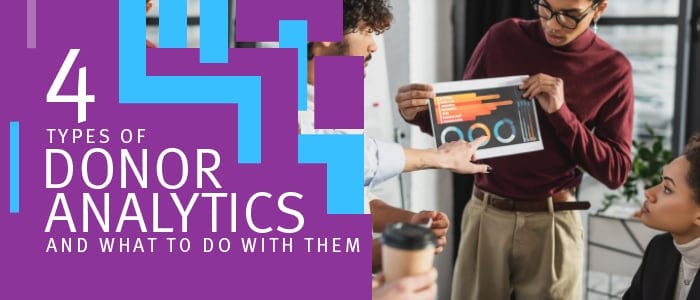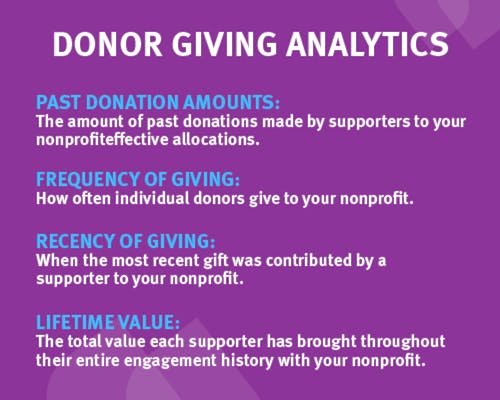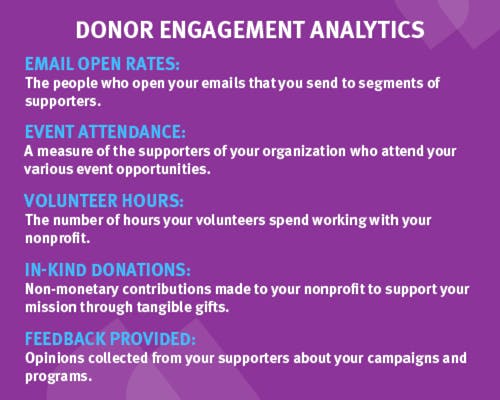
4 Types of Donor Analytics and What to Do With Them
Monday, May 16, 2022
Simple data sitting in your nonprofit’s database and financial systems don’t constitute analytics. Rather, donor analytics encompasses the conclusions you can draw from data and how you can apply those insights to better manage your organization. When you pull donor analytics for your organization, it can help you identify trends and make decisions that result in better financial management at your nonprofit.
There are several different types of analytics that your nonprofit can benefit from. That’s what we’ll discuss in this article: the types of analytics you can pull for your nonprofit and how additional insights from these analytics can result in financial stability for your organization.
We’ll cover the following types of donor analytics for nonprofits:
- Donor Giving Analytics
- Donor Engagement Analytics
- Donor Demographic Analytics
- Predictive Donor Analytics
Discerning insights from your donor analytics is the key to unlocking your fundraising strategy and raising more. With the resulting additional financial flexibility, your nonprofit can better pursue its mission, serve your constituents, and expand its services. Let’s dive in!
See how Jitasa’s JSAT team can help you better use donor analytics.
Contact UsDonor Giving Analytics
Understanding donor analytics about giving patterns allows your nonprofit to better understand your supporters’ donation habits. This can help guide your communications and make it easier to build relationships with your supporters.
You should collect data points for your donor giving analytics for each of your supporters in their individual donor profiles in your nonprofit CRM. The data that you’ll rely on for these insights include the following:

- Past donation amounts. By understanding the past donation amounts of individual donors, you can see what their average donation amount is and if it has increased or decreased. When it comes to asking for donations in the future, you’ll have an idea of the general gift amount the supporter is willing to contribute.
- Frequency of giving. Giving frequency of individual supporters can help you identify opportunities to make future asks. If a supporter donates sporadically throughout the year, you might be able to ask them to get involved with your recurring giving program, ensuring a sustainable source of income. Or, if you know a supporter tends to give once at the year’s end, you’ll know to reach them with your end-of-year campaign message.
- Recency of giving. If a donor usually gives multiple times per year but hasn’t donated at all this year, they may be in danger of lapsing. If they haven’t donated in a long time, you can reach out with a message that says “we miss you!” to recapture their support. On the flip side, if a donor just gave to your organization, it can seem greedy and out of touch if you send them another solicitation the following week.
- Lifetime value. By collecting donation information about each of your donors, you can better understand the efficiency of your fundraising efforts per donor. While you’ll calculate the fundraising efficiency ratio for your campaigns at large, boiling down your ROI per supporter can help you better understand who your most valuable donors are.
By understanding the data about your specific donors and their giving history, you can draw insights that will help you guide your fundraising asks and offer opportunities to get them more involved.
Consider for example a mid-tier supporter who gives multiple times per year to your nonprofit. Let’s say this supporter donates about $2,000 three times per year. During your upcoming capital campaign, you might try to increase their annual gift by providing a message such as the following:
“Thank you for all of your generous support over the past year! We are launching a new program now that will help x, y, and z. You can be a part of this exciting initiative if consider committing $7,000 to this single campaign this year.”
In addition to helping with individual donor relationships, tracking donor analytics related to giving allow your nonprofit to come up with new data points like your average donation amount and total revenue from individual donors. You can use this information to create a more accurate budget in the future.
Plus, you can see the fluctuations in your fundraising data over the years, allowing your nonprofit to better predict revenue trends. For example, you might find that major donations decrease leading up to elections because many supporters choose to increase their donations to political campaigns rather than charitable contributions.
Donor Engagement Analytics
Donating to your organization isn’t the only opportunity supporters have to engage with your mission. Just because a supporter hasn’t donated in a while doesn’t mean they’re not paying attention or haven’t contributed to your cause in another way.
Collect broader data about your supporters’ more general engagement with marketing efforts and alternative giving channels. Some of the data to collect per donor includes:

- Email open rates. The average email open rate for nonprofits rests right around 26.6%. Even if supporters haven’t donated to your cause, they may be keeping up with your emails! Check open rates and click-through rates per supporter to see how they engage with your email.
- Event attendance. Donors that attend events are dedicated to your campaign. Therefore, your nonprofit should be sure to track which individual donors attend your event as well as your event attendance as a whole. For your hybrid events, track who attends in-person versus virtually. That way, you can solicit feedback and better understand how each supporter engages.
- Volunteer hours. When supporters fall on hard times or simply want to supplement their contributions, they may decide to volunteer for your cause. Keep track of volunteer hours and view them as contributions of time rather than just another engagement metric. In addition, you might be able to reach out to your volunteers and ask them to check their eligibility for volunteer grants from their employers.
- In-kind donations. Similar to volunteer hours, in-kind donations contributed by supporters can be just as valuable as your monetary contributions and are assigned values as a part of your accounting processes. Supporters who haven’t contributed monetarily may still have provided in-kind contributions to support your cause.
- Feedback provided. Even negative feedback can be a sign that a supporter is engaged with your cause. Supporters only provide feedback for causes they care about, so sharing their opinions is a sign they want your organization to improve upon something.
From this information, your nonprofit can draw conclusions about your organization’s strategies and effectiveness in engaging your supporters.
Some of the insights you might determine from your donor analytics regarding engagement include:
- Optimization opportunities for your engagement strategies. You might employ A/B testing to determine the effectiveness of your emails, registration pages, and other opportunities. Or, you may solicit feedback from supporters involved with various engagement opportunities to see how you can improve.
- Prevent donors from lapsing if they become unengaged in your various activities (stop attending events, reading emails, or contributing to campaigns, for example). You can reach out to them and try to reengage them before they lapse entirely. After all, lapsed donors are only recaptured about 4% of the time, so you should try to save these supporters before they drop off.
- Show appreciation for non-monetary contributions provided for your nonprofit. In-kind donations and volunteers are often not shown as much appreciation as your donors are. However, in-kind gifts have a monetary value that you should find for your accounting standards, and volunteer hours are valued at an average of $28.54 per hour.
When supporters are engaged in more than one way with your nonprofit, they are not only more likely to be retained for the long haul, but they also provide value past monetary donations. Track individual engagement metrics per supporter, then look at the big picture of your donor analytics regarding engagement to see large-scale opportunities moving forward.
Donor Demographic Analytics
When your audience reaches out to acquire new supporters, it’s helpful to understand the demographics of your current base of support. It’s more likely that you’ll be able to reach those who share similar qualities with your current supporters than someone entirely different. For instance, a nonprofit that supports young children will likely have many supporters comprised of young parents and families.
Targeting your outreach using these types of donor analytics can help lower acquisition costs and improve your return on investment when it comes to finding new supporters.
Here are some of the demographic data you should track about your supporters:

- Age. Your average age of supporters can help provide insights regarding how your organization can best reach out to your target audience (it’s unlikely that your elderly audience will be reachable on TikTok). Plus, it can help you determine how to frame your marketing campaigns to best engage your target readership.
- Location. Location is essential to track for a couple of reasons. One, you can estimate how many locals you have as supporters to attend in-person event opportunities and how much you should invest in virtual options. Two, fundraising in different states requires your nonprofit to register with the state in which you raise money.
- Family members. When you understand the households of your supporters, your nonprofit can reach out to the entire household instead of individual members. This is especially helpful when it comes to sending direct mail as you can cut down on the cost of mailing invitations, annual reports, etc.
- Employer. When supporters work for the same employer, you might be able to discuss corporate philanthropy options with the employing company. This employer may provide matching gift opportunities, volunteer days, or other opportunities to get more of their staff members involved.
- Relevant interests. Specific interests can become the basis of effective nonprofit donor segments. This allows you to target your supporters based on what motivates and interests them relevant to your cause.
As mentioned, donor analytics covering your audience demographics is particularly helpful when it comes to marketing outreach to acquire new supporters as well as marketing to existing ones. Consider for example, how marketing on social media platforms works. You can narrow your target audience by recorded interests, age, gender, and more when you run an advertisement campaign for your organization.
In addition, these donor analytics are also helpful when it comes to creating donor segments in your existing database to run marketing and fundraising campaigns for your current audience. For example, an animal shelter may collect information about which of their supporters prefer cats and which supporters prefer dogs. Then, they can reach out with very different messages for each segment.
Predictive Donor Analytics
Also in your donor database, you can save essential information about your supporters that can help you predict their potential future involvement with your cause. These donor analytics primarily comes from prospect research data that your organization can pull about supporters.
Predictive donor analytics come from the following types of data:

- Wealth data. These metrics provide insight into the wealth of your supporters, providing insight as to the money they could potentially give to your nonprofit. Here are some of the data points you can examine:
- Real estate ownership
- Stock ownership
- Political giving
- Philanthropic data. These metrics provide information about your supporters’ philanthropic behavior, allowing you to predict their propensity to give to your nonprofit. Here are some of the data points you can examine:
- Past gifts to your nonprofit or to other similar organizations
- Volunteer hours worked at your nonprofit or similar organizations
- Memberships on your or other nonprofit boards
- Recency, frequency, and monetary value of gifts
Generally, this data is collected to help you find major gift prospects for your cause. About 88% of nonprofit funds come from the top 12% of donors, showing how important these contributions are. If you have data that indicates someone has both the potential wealth and propensity to donate, they could be a good candidate for a major donation.
Insights from these donor analytics can also help you determine the best fundraising ask to solicit from your supporters or help determine the gift levels at which to enter into conversations with your supporters. For example, if you know a supporter gave $5,000 to another organization, you might come into a conversation with them asking for the same amount. Then, ask for $3,500 if they refuse the larger gift.
When you’re able to plan out your fundraising asks with more accuracy and with the intention of maximizing your ask, you can better predict your funding and earn more funding. This makes for better budgeting in your organization and additional flexibility in your revenue. This flexibility leads to more liquidity and propensity for risk at your organization, which you’ll see reflected in your statement of financial position, and creating additional opportunities to grow.
Wrapping Up
The data used to drive insights from your nonprofit’s donor analytics is essential information for your organization to determine the key performance indicators for your fundraising strategy. Not only can you use them to determine these KPIs, but you can also find metrics to support your pursuit of these goals.
If you’re looking for an opportunity to use your own donor analytics to determine the right KPIs to increase your nonprofit’s revenue, the experts here at Jitasa can help! Our JSAT team will work with your nonprofit to create a budget, determine a strategy, and uncover opportunities to increase your funding. When you do, our team will also help you allocate those resources and track your finances to continue supporting organizational growth.
If you’re interested in learning more about donor analytics and nonprofit finances, check out these additional resources:
- Form 990 Filing: Your Essential Guide to Nonprofit Taxes. Each year, you’ll need to report your earnings to the IRS, learn more about this process and how new nonprofit growth affects it with our File 990 guide.
- Nonprofit Budgeting: Understand the Basics + Template. One of the benefits of collecting data and interpreting donor analytics is that you can have a more sustainable income. See how to use this information to create the best budget for your nonprofit.
- Nonprofit Audits: A Complete Guide to Financial Auditing. Also with new growth and enhanced strategies comes the potential for a financial audit. Far from a scary process, this guide walks you through how an audit can actually help your organization continue to grow.

Start better leveraging your donor analytics today!
See how our JSAT team can help you measure and use your data.
Contact Us